Getting to Know Gran Canaria
The Macaronesian region is only 115 km away from the African coast.
While it includes the Azores, Cape Verde, Madeira, the Salvages, and the Canary Islands – all volcanic – the latter are closest to the giant continent.
The Canary Islands were not named after the bird, but the bird may well have been named after the islands.
They enjoy a subtropical climate and a great rivalry between them.
The seven main islands have a strong individuality and cater to aficionados of various sports.
Gran Canaria is the most populous of all the Canary Islands.
It is less windy than Lanzarote and Fuerteventura and much greener than Lanzarote.
Plus, its variety of landscapes (with the great choice of climbs) makes Gran Canaria ideal for cycling.
Lovers of the sport come here year-round. You are probably one of them, so let’s cover all the details and convince you to grab your bike and head there.
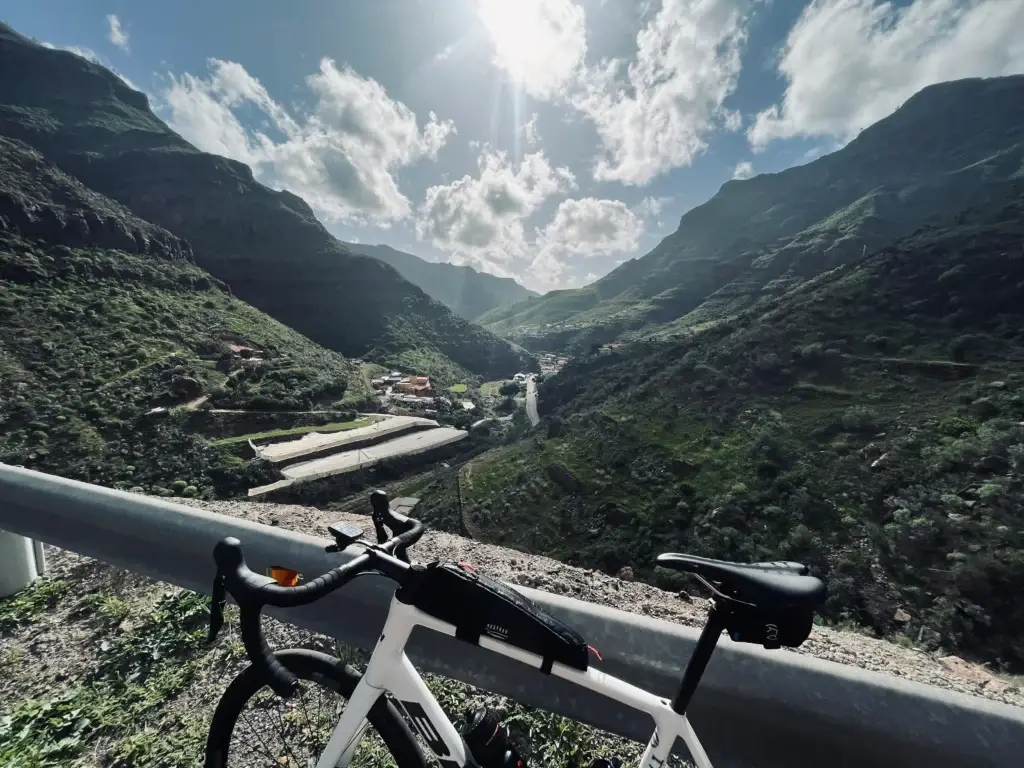
Locations to Ride
Let’s start with the Circular Route (approximately 200 km); it is doable in one day for experienced riders.
For an excellent (and unforgettable day out), here’s a loop starting with the quiet Soria Climb (5 km), then the pine-dominated Serenity Climb (9 km) to Ayacata, and then Pico de las Nieves (22 km), a spectacular route spanning nearly 2000 m above sea level. The descent back to the coast will be interesting, to say the least.
Another loop (shorter though, 26 km) is the ride from Maspalomas to the pretty village of Ayagaures; it will take about two hours on quieter roads with impressive views.
If you’re staying north and want a different approach to the Valley of Tears, start your ride in Arucas and head south along the Agaete River Basin, full of orange trees and coffee plantations.
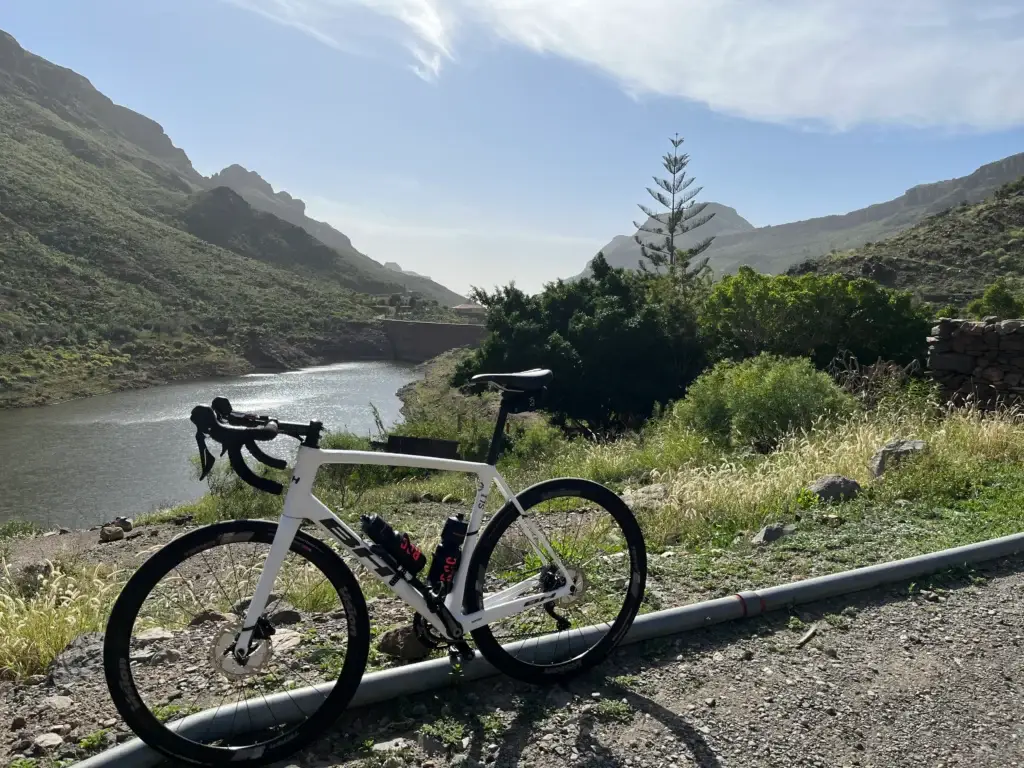
Top Guided Cycling Tours Gran Canaria
Gran Canaria may be a small island, but the cycling opportunities abound.
General Tours
If you want an epic (but guided) tour, then the Tour of Gran Canaria is for you. There are 6 days spent around the mountains of Gran Canaria, with an ample selection of hotels and bikes.
Training Camps
Gran Canaria has (rightfully) gained its reputation as one of the best training spots in the winter sun. The Gran Canaria Road Bike Camp is a must for all cyclists trying to get back into shape or get out of their comfort zones.
Specialist (solos, self-guided, e-bikes) Cycling Holidays Gran Canaria
Solo and self-guided tours are available; breakfasts, airport transfers, and accommodation are included. They can be, however, upgraded to guided tours (with full boarding).
E-bike tours are usually guided; you’ll find them around Maspalomas and its dunes (and can include tapas for the stops).
Where to Stay in Gran Canaria
The accommodation spaces are not the cheapest. It is also probably a good idea to go for an apartment, a holiday home (if you’re a group travelling), or a guesthouse. They will be more flexible than a hotel with storage for your bike (especially if you are travelling with one).
As you’ll notice throughout the article, the greatest weather-related suggestion (even considering the 23⁰C average temperature!) is to stay in the south of the island. It is drier and closer to more interesting climbs and rides.
So, how about
Maspalomas
You’ll be spoiled for choice in this larger town.
Granca Live Home is a colourful place to host you during your cycling adventures;
Refugio en el Mar gets you closer to the beach and lets you enjoy the comfort of a great terrace.
Arguineguín
If you need a more tranquil base, this place is for you!
Melina is pretty close to the beach (750 m) and is a charming apartment featuring a hot tub.
Cycling Essentials for Gran Canaria
This is the most important part of the guide if you wish to take care of all those final details before starting your Gran Canaria cycling holidays.
When to Cycle in Gran Canaria
The best thing about the weather in Gran Canaria is that you can cycle year-round (and enjoy those steady climbs!).
However, the best time to go is in spring [beautiful green landscapes and excellent riding conditions], autumn [quieter roads], and winter [ideal as a winter escape].
Bike Hire in Gran Canaria
Free Motion is a great option, as they have several stores around the island.
Specific Bike Stores or Chains
As mentioned above, Free Motion (with shops in Las Palmas, Puerto de Mogán, Arguineguín, Meloneras, Dunas Suites and Villas, Playa del Inglés, and San Agustín).
What to Pack
Besides your cycling apparel (we know that you got that covered!), pack sun protection year-round. Also, pack thick clothes for those high altitudes, trekking boots if you plan to hike, and many layers.
How to Pay in Gran Canaria
Either in cash (Euros) or by card! Small amounts (and tips) are usually paid in cash. Bus fares are paid by card, as it is quicker.
Gratuities
Leave 5-10% in restaurants; round the cost for taxi rides.
Tips for Cycling in Gran Canaria
The legal part:
Wear helmets (they are mandatory outside urban areas and mandatory for cyclists under 16 everywhere) and protective clothing. It is illegal to speak on the phone and wear headphones. Lights are mandatory in tunnels.
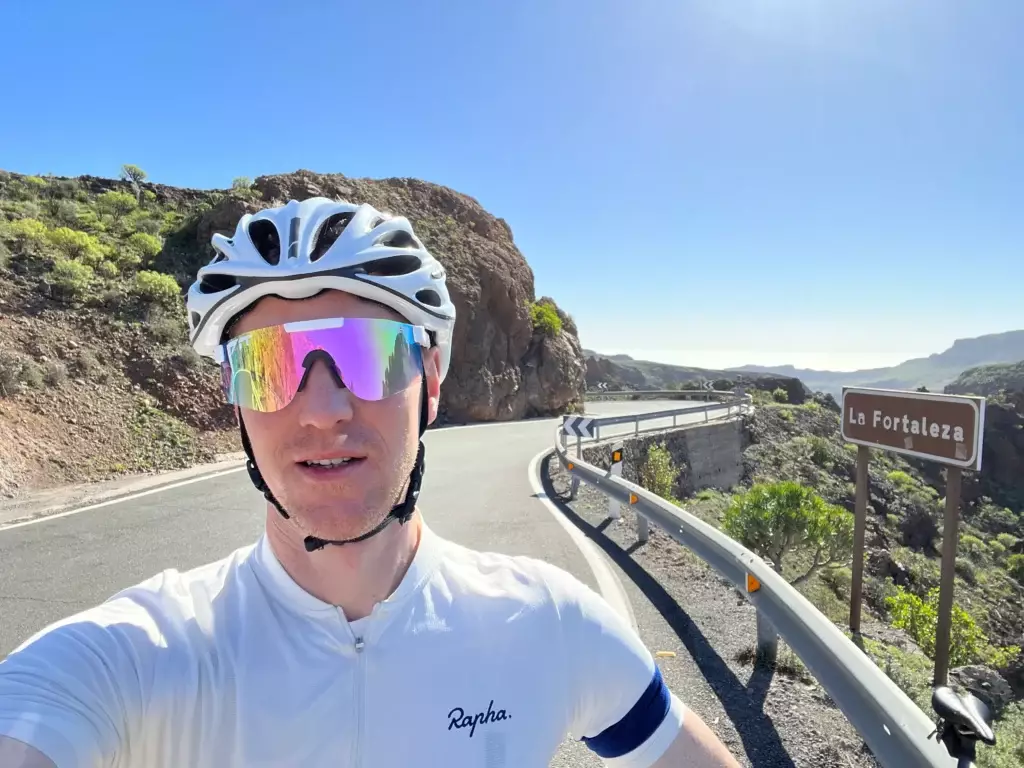
Other common sense tips:
Wear bright clothing – no black ;). Keep a repair kit and a mobile phone with you at all times (you never know). Plan your routes and share them with someone not joining you on your ride.
Carry enough water and snacks for energy, especially when you plan to go on longer rides. Think of recovery meals: oatmeal and raisins should work just fine. You can either bring them or buy them upon arrival.
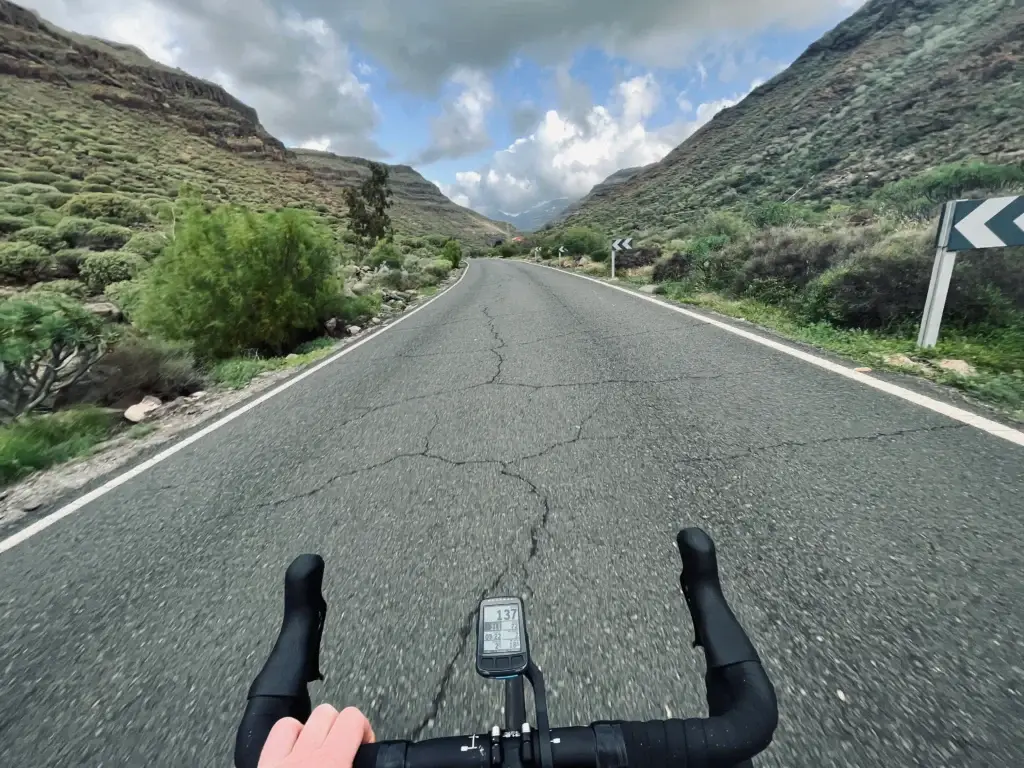
Best Coffee Stops in Gran Canaria
- Arguineguín: Anfitrion Coffee Corner [claimed by some as the best on the island; and they serve carrot cake].
- Las Palmas: Cool Beans [great vibes, great coffee, great coffee cups].
- Kafema [another contender for the ‘best-brewed coffee of the Canaries’, plus delicious food and sweets]
- Maspalomas: Calma Café [not only excellent coffee but also varied breakfast options]
- Playa del Inglés: La consentida de Maspalomas [they bake some interesting pizzas on top of the great coffee]
- Nuevo Rokoko [you can also try their cakes and sandwiches; great ambience]
- If you’d like to have some tea instead, head to Mac’s Tearoom, a great little tea room in Playa del Inglés.
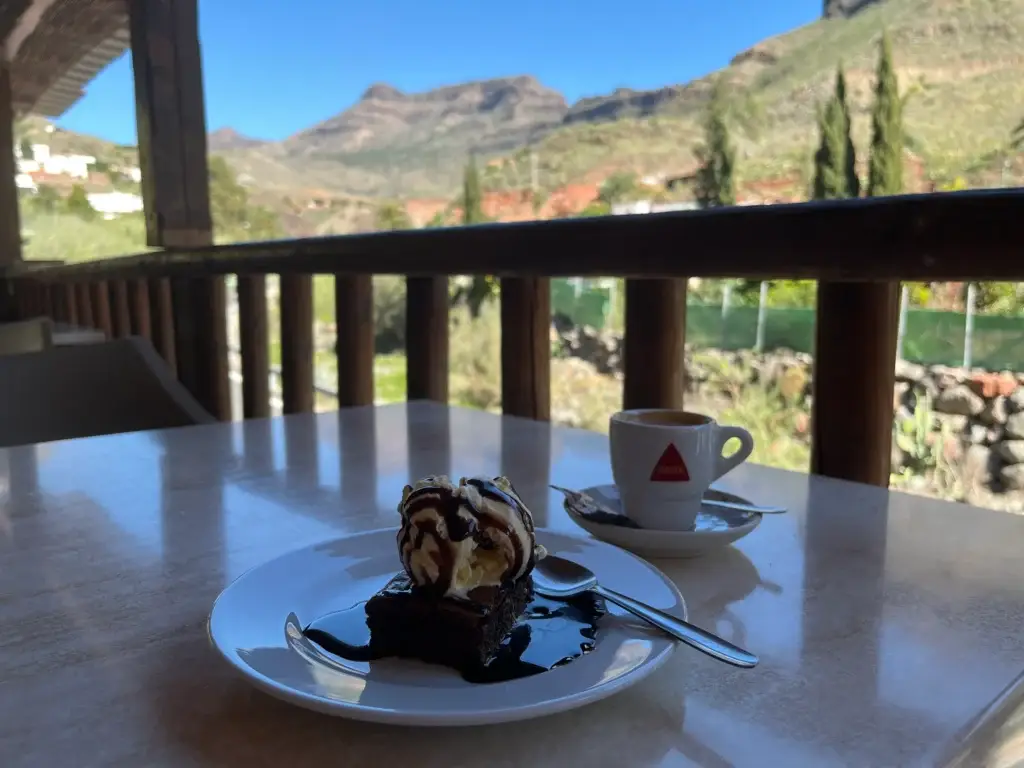
Cycling Events in Gran Canaria
If there are 229 km suited for cycling, then there are events to cover them.
Right at the beginning of a new year, in February, there’s Epic Gran Ganaria, namely 3 days to enjoy. The last two hold the 2 competition stages and 3 time trials ‘to fight for the general classification in a cycling experience normally reserved for professionals’.
Also at the start of the year it’s time for Desafío la Titánica. Cyclists can choose from two challenges – Valley of Tears (VOT, 143 km) and Los Azulejos (96.50 km).
Since 2001, at the beginning of December, there’s Gran Fondo Pico de las Nieves, the most difficult of the cycling events/challenges on the island. There are two more categories (Advanced and Starter) to select if you are not yet ready for the toughest mountain pass in Europe.
Also in December, there’s Gran Canaria Bike Week – La Cicloturista or 7 days around the island. It is an event that has been celebrated since 1988, usually during the first days of the month.
Getting to and Around Gran Canaria
Getting to Gran Canaria usually happens…
By plane
There are good airfare deals from Western (even Eastern!) Europe and Western Africa. You will find flights from South America, Western Asia, and Eastern North America under EUR 1000. The most expensive tickets are those from Australia, at around EUR 1600.
Also, the connections between the Canary Islands are solid by air (see Binter and CanaryFly).
By ferry
You can also arrive by ferry, which has regular connections to mainland Spain and Morocco.
Different companies serve different Canary Islands. Depending on your route and travel plan, you can select and buy your tickets before your travelling date; (see Armas, Fred Olsen, Líneas Romero, and Biosfera Express).
Getting around Gran Canaria is easy
By car
You will find plenty of car rental companies. It will be easier to get around for days when you wish to let your bike have a rest.
By bus
The bus network is well-developed (and you can even carry your bike along).
By boat
There are boats especially in the southern part of Gran Canaria; you can take your bicycle with you and even combine the ocean ride with some dolphin and whale spotting.
There are no trains in Gran Canaria at the moment, but there is a project to introduce one.
Beyond Cycling: Other Attractions
What not to miss during your cycling trip?
P.S. Always remember that you also need days to relax; in the end, you’re doing it for fun.
- the superb 8 km-long beach between San Agustín, Playa del Inglés, and Maspalomas; Las Dunas de Maspalomas are indeed a sight;
- Puerto de Mogán, which is a must for all seafood lovers;
- Playa de Güigüí – remote and difficult to access (only by boat or hike), but wonderful nonetheless;
- Tejeda Village – some call it the most beautiful on the island; others – one of the most picturesque in Spain;
- Las Palmas de Gran Canaria, the island’s capital city, which is located on a stretch of sand providing seaside views on both sides; don’t leave without exploring the Vergueta Neighbourhood with its Casa de Colón (Columbus’ House), hosting important information of the 4 stops that Columbus allegedly made in the archipelago before heading across the ocean.
Our Recommended Itinerary
A ride around the island is approximately 200 km. It is consequently doable in a day, at a push! This is why we won’t discuss tour riding but base riding. A cycling holiday in Tenerife offers a unique opportunity to explore the island’s diverse landscapes, from rugged coastal roads to challenging mountain climbs. By focusing on base riding, you can take your time to enjoy the breathtaking scenery and tailor each day to your skill level and preferences. This approach ensures a more relaxed and enjoyable experience, allowing you to truly immerse yourself in Tenerife’s cycling paradise.
And if we got to that, a good spot to use as a base would be located around Maspalomas in the south, providing easy access to great climbs and rides. It also provides access to shorter challenging rides from the drier south of Gran Canaria.
Key Takeaways
What have we not covered so far (and should)?
The roads (generally good or bad)
Generally good (red and green), questionable (yellow), and highways (blue, which you can’t ride); don’t worry about your safety; think only of the cycling days ahead.
Food: One thing that’s a must-try
The dulce de leche (a type of caramel spread) made on the island! Your breakfasts will take a different turn. Your dulce-de-leche-topped or filled desserts will have an extraordinary taste!
Climate: Bring sunscreen or a rain jacket
Bring both! You’ll need sunscreen all around Gran Canaria and a rain jacket if you travel to the northern part of the island, where the climate tends to be more humid.
One ride: If you could only do one ride, this is THE one
Start in Puerto de Mogán and ride through Mogán to VOT (Valley of Tears, 12 km). It may not seem like a difficult climb, but it is – maybe you will cry! Prepare for that, but also for the joy of the challenge and the views. You will ride from Presa del Parralillo (Parralillo Reservoir at 300 m to the summit at 1380 m). There is no room for zigging and zagging.
As a variation, Líneas Salmón offers an affordable and fun water-taxi-type ride from Puerto Rico, Arguineguín, and Anfi del Mar to Puerto de Mogán. It only depends on where you are staying in the south. You can take your bike along.
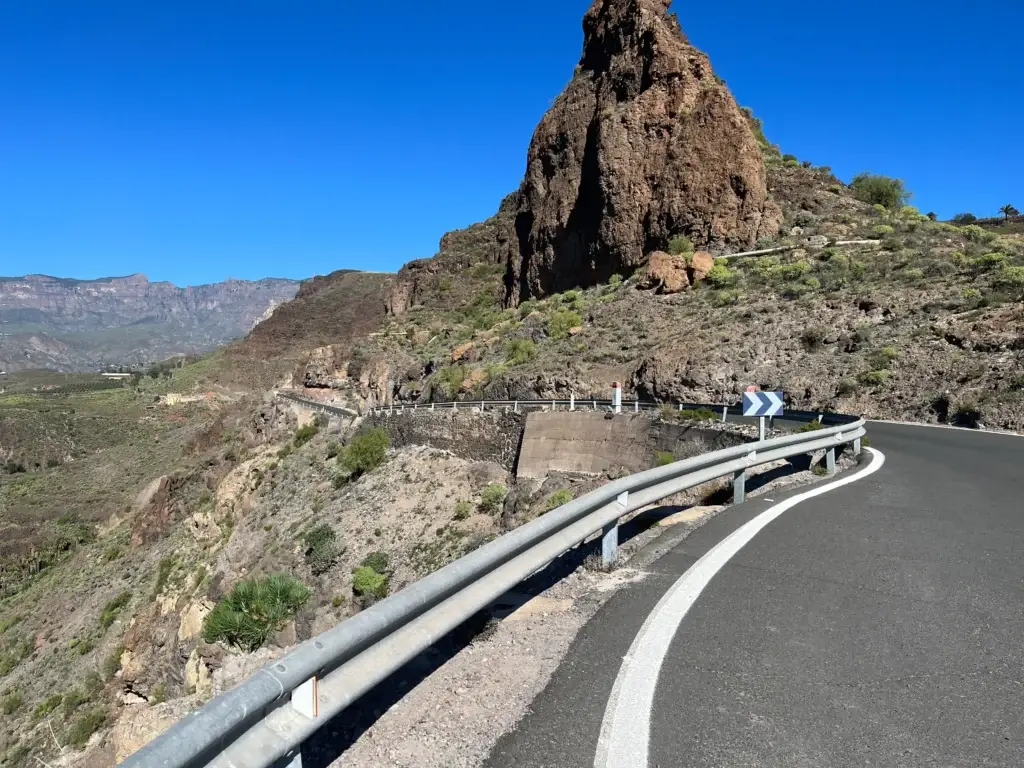
Frequently Asked Questions
We are here to answer more questions!
What is the cost of a cycling holiday in Gran Canaria?
EUR 1600 to EUR 2100 for a 6-day tour of Gran Canaria (excluding flights). Of course, the accommodation and meals will be included.
If you decide to organise the cycling holiday on your own, your total would be around EUR 850 (excluding meals and flights). This cost typically includes bike rental, accommodation, and route planning, giving you the flexibility to tailor the trip to your preferences. Popular cycling holiday destinations in Europe, such as the Netherlands, Italy, or France, offer a range of scenic routes suitable for all skill levels. With careful planning, you can create a memorable experience while staying within budget. This price typically includes accommodation, bike rentals, and any necessary permits or fees for cycling trails. To make the most of your trip, it’s worth researching cycling holiday tips and destinations to tailor your itinerary and ensure you cover the most scenic routes. Planning ahead also gives you the chance to discover hidden gems and avoid any unpleasant surprises along the way.
Which are the top cycling tours in Gran Canaria?
Free Motion offers a variety of tours (the rates are listed without a bike rental). You can select one based on the type, season, and level of difficulty.
How is the cycling experience in Gran Canaria?
You can ‘play’ around and test yourself and your skills. Gran Canaria may not be big enough for touring, but it is great for climbs (there aren’t too many flat parts, to be honest).
What makes a cycling holiday in Gran Canaria special?
Quality and challenging rides year-round, especially when most of the Northern Hemisphere is facing winter temperatures! With its mild climate, smooth roads, and stunning volcanic landscapes, this Canary Island offers an unparalleled experience for cyclists of all levels. Whether you’re tackling steep climbs, enjoying coastal routes, or exploring its unique terrain, Lanzarote is a paradise for cycling enthusiasts. It’s no wonder so many consider it the ultimate cycling holiday in Lanzarote, combining exceptional riding conditions with breathtaking views and year-round sunshine.
